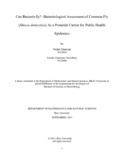Can bacteria fly? - bacteriological assessment of common fly (Musca domestica) as a potential carrier for public health epidemics
Abstract
The primary aim of the research work is to analyze the diverse bacterial presence in the houseflies (Musca domestica) found from the fish markets and street food in some major areas of Dhaka city. Common house flies (Musca domestica) are familiar phenomena in the environment as they get suitable conditions to survive amidst harsh environmental conditions than any other pests.
During the study, 30 housefly samples obtained from different locations in Dhaka from which 148 isolated colonies were recovered from various selective and non-selective media plates (MSA, XLD, TCBS, Cetrimide, MacConkey agar and nutrient agar). Most expected organisms from the samples were Pseudomonas aeruginosa, Klebsiella pneumoniae, Vibrio cholerae, Salmonella typhi, and Staphylococcus aureus. For the identification, biochemical testing and conventional PCR methods were used. On the basis of the biochemical testing, isolates were thought to be different organisms, including K.pneumoniae (7.43%), Pseudomonas aeruginosa (7.43%), Serratia marcescens (14%), Proteus spp. (5%), and others which cause various enteric and nosocomial diseases in humans. In addition, PCR confirmation included 7.43% Pseudomonas aeruginosa, 4.73% Vibrio genus, 7.43% Klebsiella pneumoniae and others. However antibiotic susceptibility tests using Kirby-Bauer Disk Diffusion method were followed to overview ongoing conditions of antibiotics. Among all the antibiotics vancomycin showed almost 73.68% sensitivity to most of the organisms and 10.53% resistance. Following that ciprofloxacin showed 94.55% sensitivity to most organisms. On the contrary, erythromycin (58.18%) and Tetracycline (28.18%) gave small zones that indicated resistance against those organisms. Besides, Amoxicillin showed a high range of resistant zones. It was assumed that such resistance towards necessary antibiotics can create severe public health concerns adding that house flies can transmit the pathogens containing resistance genes with them acting like a carrier in the environment.

